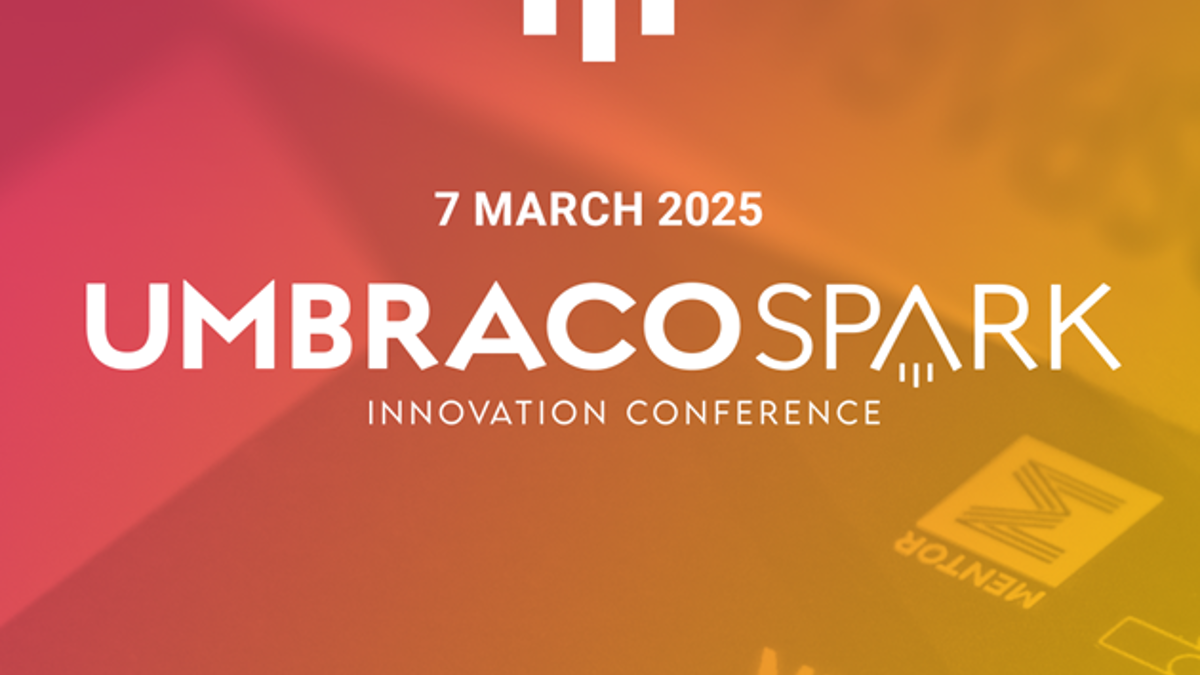
Umbraco Business Summit
Our adventure officially started on Tuesday when we arrived in Odense to register for the Business Summit, which is all about bringing Umbraco Partners together to show us what has been achieved over the last year and to give us a taste of what is happening over the next year. This did give us insight into some exciting new features, but unfortunately no concrete date for when we’ll get them. It was great to come away at the end of the day knowing there are still ways to improve on an already awesome product.
Firstly, Umbraco was quick to show us that it is now the fastest growing CMS, which is great to see. It now has almost 1 install every minute. The Content Management industry is growing massively and it’s nice to see Umbraco staying ahead.

The core Umbraco team seem to have spent the last year reflecting on what Umbraco really is. With Headless, Microservice architecture, and the increasingly number of ways content can be delivered to end users, it’s becoming more important for Umbraco to be a CMS solution that can fit within all these architectures, as well as still support the traditional way it has been used in the past. Umbraco is also delivered as a blank slate to help developers provide a CMS that meets client requirements. Therefore, Umbraco has officially labelled itself as a CMS Platform, something that is more of a tool on our belt that can be customised to fit in a solution and without requiring compromise.
Most importantly, Umbraco has spent the last few years planning and developing a new UI based on Web Components that was officially released on the 30th May 2024. This is not just a huge step away from AngularJS, which is now no longer supported, but a step towards a technology for the Backoffice that will continue to be supported in many years to come. Additionally, a new project structure was introduced so that the Backoffice and frontend can be hosted completely separately. Although this was previously possible, this time the frontend doesn’t come with the Backoffice installed. This is a huge step towards making it simpler to separate out the Backoffice and frontend applications and providing infrastructure level access security.

This year, Umbraco highlighted the increasing importance of AI and the benefits it can provide our content editors. There are many ways AI can be used to assist content editors, and this requires a community effort to seek out new and exciting ways with how it can be used. This includes how it can fit within the Backoffice. So, Umbraco showed its eagerness to see us explore AI together and come up with amazing solutions. This may lead to official integrations later, a standardised way to integrate new AI services into pre-integrated solutions, or the decision to leave Umbraco as-is and let the community produce and improve upon community-managed packages. This is certainly something we are eager to explore.
The day ended nicely with a sit-down 3 course meal where we sat and chatted with a development director from Colorado, and Christian Tvede - the incredibly Danish HR VP. Christian seemed to be everywhere we went, whether it was the swag shop, reception or lost property he seemed to be there before us.
We had 9 plates of food for four people... Many prawns were eaten that night!

During the meal there was a presentation by lecturer Emilia van Hauen talking about how to attract and retain young workers. There was a lot of discussion on the differences between different generations and how communication has changed over the years, but the crux of the message seemed to be that people need to feel included socially as part of the tribe to enjoy an environment.
The most interesting part was a thought experiment where everybody was asked to remember the best moments of their life. A show of hands revealing that none of these memories had anything to do with large amounts of money but largely involved other people and shared experience. We must engage new talent in our society to keep them.

Umbraco Codegarden Talks
Codegarden started with us all getting a free shirt, (socks extra) to add to the already large pile of shirts that is mandatory for anyone involved in Umbraco, perfect for the next trip to one of the next Umbraco events.

We saw Umbraco t-shirts being worn in the airport, train station and well, pretty much everywhere – a testament to the number of bods that descended on Odense this year.
Keynote
The event started with the Keynote, which summarised a lot of the information from the Business Summit into one hour and toned down towards the community members.
Umbraco announced its interest to see more AI packages and highlighted its importance in its future. There were plenty of talks planned over the next few days to discuss AI as a topic, so this nicely flowed with what seemed to be the general theme over the next few days.
With the release of Umbraco 14 on the 30th May 2024, it is now the latest version of Umbraco but is the short-term support (STS) version. Umbraco 13 is currently the latest long-term support version and the focus for this version is now shifting to stability and security. This means Umbraco 13 will not receive any new features but instead will be improved upon with what it already does well. Umbraco 14 is the first release towards Umbraco 17, which will be the next major long term support version that will have the new Backoffice and plenty of new features by the time it is released.
The Talks
There were a few talks about AI. We were keen to join as many as we could and we were delighted to come away with a very good idea on how AI could be used, how we could experiment ourselves with Umbraco to complement our own solutions and further our advancement with how it can help us in the production and maintenance of an Umbraco solution.
Umbraco already had a few AI packages that provided AI integration, all with their own ideas about how AI could assist Content Editors and developers.
Some really cool ideas, features that are already available, or on the way include
For Content Editors:
- Content:
- Tone of voice analysis of text
- Spelling and Grammar
- Generative AI for content:Creation of pages with pre-populated content
- Prompts to create content for specific fields in the CMS
- Generate good tags for content
- Generate a nice url for the page
- Generate a good meta description that will work well for SEO
- Lengthen or shorten text
- Direct TinyMCE rich text editor integration with preconfigured prompts
- Media:
- Generate images
- Describe an image for an image html alt attribute
- Automatically set focal points for image cropping
For Developers:
- Log Viewer integration to explain and help resolve errors
The problem that was highlighted was the various approaches taken and how eventually mixing and matching these packages would lead to some conflicts and overlap of functionality. It was a useful insight into why Umbraco should consider implementing a standard for providing these integrations in a way that makes it easily upgradable, easy to switch out, and implement our own and customise. I expect the next few years to be very exciting in this area.
Before we move on from AI, there was an extremely interesting talk called Being Human. This warned us of how AI has been around for a long time and only with the rise of ChatGPT has AI become a popular topic at home and the workplace. It highlights the trend of most technology how we build up high expectations for what we hope to achieve, which eventually leads to what is realistically possible and disappointment, but it’s only at this point do we lead to how we can productively use something and find purpose for it. The first step is the riskiest, can lead to over-investment for only a disappointing return, without the right caution from the get-go. I imagine we will go through this high expectation phase to see what’s possible, and it’s our job to ensure we proceed with as much caution and control expectations so that we can aim high but not over-promise what can be achieved.
Now we move on to what’s new with Umbraco 14. It’s important to note that Umbraco 14 doesn’t necessarily provide any new features for CMS editors for this version. But this version is a huge advancement under the hood with how it is architected, and the technology that is used.
Umbraco 14 is now built using Web Components, which is a huge step away from the outdated AngularJS. The Umbraco Backoffice is now made up of a huge library of reusable Web Components and UI Components that can be reused by developers but make up what is seen in Umbraco 13 with all the standard behaviour. This definitely helps Backoffice development feel more controlled and less like the wild west of development when trying to extend the Backoffice. It does mean however, like the shift from Umbraco 6 where extensions were built using ASP.NET Web Form controls, to Umbraco 7 where we had to familiarise ourselves with AngularJS, we are now moving to a more stable technology that should pay off in the long term.
We were excited to see some new features that are planned over the coming years, unfortunately with no fixed dates, but we are excited to see these new features on the radar. First is Block Editor variants, which work similarly to how variants work for multi-lingual, except it should be possible to create variants of the same Component in Umbraco but control which variant is rendered based on the persona of the user – which is great for personalisation. Prior to this, it can be quite difficult to achieve without compromising the content editor experience.
Then we move on to global Components, which provides a new section in Umbraco to manage reusable Block Editor components that can be reused on multiple pages. This is something we have developed ourselves, but to have this provided out of the box will help reduce the effort required compared to doing it ourselves.
Next is the ability to switch out the Indexing Provider in Umbraco. Currently Umbraco uses Examine to index content, which under the hood uses Lucene. This can be difficult when trying to separate out responsibilities in a multi-application architecture. Currently Umbraco provides the content and provides the search, but this will allow us to separate out the search and use the best tool for the job depending on the needs of the client. Already we have seen solutions being produced that provide content indexing and search using AI, so this will be a huge leap if these services can be plugged in without the need to write our own extensions.
In summary, Codegarden proved that Umbraco and its community are driven to stay ahead of the curve, continue to reflect on how it can do better without becoming a biased CMS, and most of all, remind us that Umbraco has a community full of talent that is its driving force and is why Umbraco will continue to be our favourite CMS. Additionally, Odense was a great place to host this event, with so much architecture to look at.



